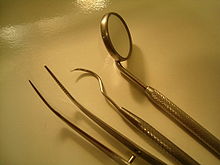Probe (dentistry)
A probe ( französ. Probe , probe) referred to in the dentistry an instrument for examination of teeth and gums . It is part of the basic set of dental instruments, which is usually freshly applied to each patient by the dental assistant before treatment begins. A distinction is made between probes for examining hard tissue and probes for examining the gingiva ( periodontal probes ). In addition, dental probes are used in dental technology.
Hard tissue probes
With these probes, cariously softened areas in the tooth enamel can be diagnosed during the dental examination. In addition, roughness can be determined on the tooth surface. Probes are also used to check the tight marginal fit of crowns and inlays .
A distinction is made between different forms of dental probes, which can be single or double-ended, short or long, small and large:
- Universal probe, bent or angled
- Cow horn probe,
- Forward and back hook probe
- Check probe
- Crescent-shaped probe
Periodontal probes
Periodontal probes are also known as periodontometers . These instruments can be used to measure the depth of gingival pockets in periodontal and peri-implantitis diagnostics . For early detection of periodontal diseases, the periodontal probes are used to collect the periodontal screening index (PSI). The probes are either provided with colored markings or notches so that the pocket depths can be read off. There are various modifications, the WHO probe being the most common.
- WHO probe, single-ended, with markings at 0.5 mm, 3.5-5.5 mm, 8.5 mm and 11.5 mm. From a pocket depth of 3.5 mm, according to the guidelines of the Federal Joint Committee, the cost of periodontal treatment is covered by the statutory health insurance in Germany. In order not to injure the gums, the end of the probe is rounded off with a small ball 0.5 mm in diameter. The first mark is made after 3 mm, so that when the mark is countersunk, a total pocket depth of 3.5 mm can be measured.
- Williams periodontometer with notches or colored markings at 1 mm, 2 mm, 3 mm, 5 mm, 7 mm, 8 mm, 9 mm and 10 mm.
Bifurcation probes
The periodontometer according to Nabers is used to measure exposed bifurcations . It corresponds to a sickle-shaped probe for caries diagnosis, but which is provided with length markings every 3 mm and a blunt tip.
Other dental probes
Miller needle
The Miller needle is a probe that is used in dentistry to find and probe root canals .
DNS probe test
With the help of thin paper probes (paper points), samples can be taken from the gingival pockets in order to have them genetically examined in a laboratory. A targeted search is made for the marker germs or for parts of their DNA (genetic material). First, three types of bacteria are examined, but up to five other bacteria can be detected using a DNA probe test. These include Agregatibacter actinomycetemcomitans , Porphyromonas gingivalis , Prevotella intermedia , Tanerella forsythesis and Treponema denticola .
Button probe
Blunt button probes , for example the Bowman button probe , which he originally developed as a tear duct probe , are used to probe a fistula duct of a dental fistula . It can also be used to diagnose an oral-antral connection (MAV), the opening of the maxillary sinus after the extraction of a molar in the upper jaw .
Probes in dental technology
In dental technology, waxing probes are used for modeling wax models in the manufacture of dentures , for example in gnathology waxing instruments according to Peter K. Thomas .
See also
Individual evidence
- ^ Th. Hoffmann, B. Willershausen: Conservative Dentistry and Periodontology. Thieme, 2010, ISBN 3-13-593703-8 .
- ↑ Dentistry in checklists . Spitta Verlag GmbH & Co. KG ,, ISBN 978-3-934211-36-0 , pp. 74–.
- ↑ P. Reuter, Lexikon Medizin , Springer Verlag (2004) p. 293, ISBN 3-540-20412-1
- ↑ PKT Thomas Waxing Technique



